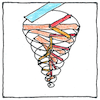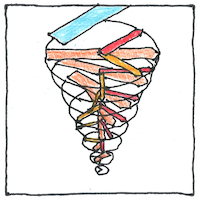Vagn Walfrid Ekman,
Fridtjof Nansen
oceanography

|
Ekman transport
Fridtjof Nansen noticed that ice on the northern seas travels at an angle to the direction of the wind. Vagn Walfrid Ekman found this is due to the Coriolis effect, the ice being pushed against the wind by water at the surface, which, in the northern hemisphere, moves ninety degrees clockwise to the wind.
Ekman spiral
Under a block of sea ice, where turbulence is calmed, each layer of water pushed by the wind and deflected by the Coriolis effect in turn deflects the layer under it, resulting in a descending spiral that tapers to nothing three hundred feet below the surface.
Coastal upwelling
Every molecule in the ocean dances with its partners in loose companies. Where one turns along a shore another rises to take its place.
Balance of forces
Stokes drift Coriolis effect Water viscosity Wind resistance If a balance of forces doesn’t magically result in a unified flow, energy is dissipated in turbulence. Yet sometimes off we go northeast.



Vagn Walfrid Ekman established the principle known as the Ekman spiral based on data that Fridtjof Nansen gave him from the Fram expedition of 1893-1895.
See also in The book of science:
Readings in wikipedia: